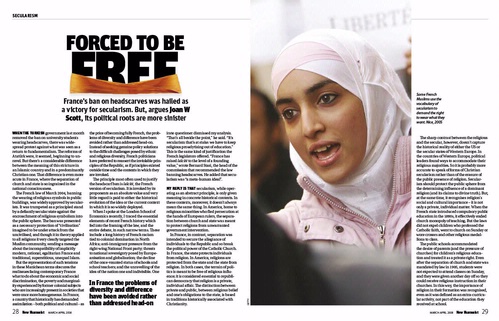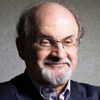When the Turkish government last month removed the ban on university students wearing headscarves, there was widespread protest against what was seen as a return to fundamentalism. The reforms of Atatürk were, it seemed, beginning to unravel. But there’s a considerable difference between the meaning of this stricture in an Islamic country and in a predominantly Christian one. That difference is even more acute in France, where the separation of church and state is so ingrained in the national consciousness.
 The French law of March 2004, banning the wearing of religious symbols in public buildings, was widely approved by secularists. It was trumpeted as a principled stand by a defiantly secular state against the encroachment of religious symbolism into the public sphere. The ban was presented as a necessary protection of “civilisation” imagined to be under attack from the uncivilised, and though it in theory applied to all religions it very clearly targeted the Muslim community, sending a message about the incompatibility of implicitly modern, rational, egalitarian France and traditional, superstitious, unequal Islam.
The French law of March 2004, banning the wearing of religious symbols in public buildings, was widely approved by secularists. It was trumpeted as a principled stand by a defiantly secular state against the encroachment of religious symbolism into the public sphere. The ban was presented as a necessary protection of “civilisation” imagined to be under attack from the uncivilised, and though it in theory applied to all religions it very clearly targeted the Muslim community, sending a message about the incompatibility of implicitly modern, rational, egalitarian France and traditional, superstitious, unequal Islam.
But the representation of such tensions in these Manichean terms obscures the real issues facing contemporary France: what to do about the economic and social discrimination, the poverty and marginality experienced by former colonial subjects who are increasingly present in societies that were once more homogeneous. In France, a country that historically has demanded assimilation – both political and cultural – as the price of becoming fully French, the problems of diversity and difference have been avoided rather than addressed head-on. Instead of seeking genuine policy solutions to the difficult challenges posed by ethnic and religious diversity, French politicians have preferred to reassert the inviolable principles of the Republic, as if principles existed outside time and the contexts in which they are invoked.
The principle most often used to justify the headscarf ban is laïcité, the French version of secularism. It is invoked by its proponents as an absolute value and very little regard is paid to either the historical evolution of the idea or the current context in which it is so widely deployed.
When I spoke at the London School of Economics recently, I traced the essential elements of recent French history which fed into the framing of the law, and the entire debate, in such narrow terms. These include a long history of French racism tied to colonial domination in North Africa; anti-immigrant pressure from the right-wing National Front party; threats to national sovereignty posed by Europeanisation and globalisation; the decline of the once-vaunted status of schools and school teachers; and the unravelling of the idea of the nation one and indivisible. One irate questioner dismissed my analysis. “That’s all beside the point,” he said. “It’s secularism that’s at stake: we have to keep religious proselytising out of education.” This is the same kind of justification the French legislators offered. “France has raised laïcité to the level of a founding value,” wrote Bernard Stasi, the head of the commission that recommended the law banning headscarves. He added that secularism was “a meta-human ideal”.
My reply is that secularism, while operating as an abstract principle, is only given meaning in concrete historical contexts. In these contexts, moreover, it doesn’t always mean the same thing. In America, home to religious minorities who fled persecution at the hands of European rulers, the separation between church and state was meant to protect religions from unwarranted government intervention.
In France, in contrast, separation was intended to secure the allegiance of individuals to the Republic and so break the political power of the Catholic Church. In France, the state protects individuals from religion. In America, religions are protected from the state and the state from religion. In both cases, the terrain of politics is meant to be free of religious influence; it is considered essential to republican democracy that religion is a private, individual affair. The distinction between private and public, between religious belief and one’s obligations to the state, is based in traditions historically associated with Christianity.
The sharp contrast between the religious and the secular, however, doesn’t capture the historical reality of either the US or the secular states of Western Europe. In the countries of Western Europe, political leaders found ways to accommodate their religious majorities. So it is probably more accurate to speak of forms of Christian secularism rather than of the erasure of the public presence of religion. Secularism should protect the public sphere from the determining influence of a dominant religion (and its claims to divine truth). But, at the same time, it recognises religion’s social and cultural importance – it is not only a private, individual matter. When the French state introduced compulsory public education in the 1880s, it effectively ended church monopoly of teaching. But the laws did not expel children who professed the Catholic faith, went to church on Sunday or wore crosses and other religious medallions to class.
The public schools accommodated the desire of parents (and the pressure of churches) for children’s religious education and treated it as a private right. Even after the separation of church and state was mandated by law in 1905, students were not expected to attend classes on Sunday, and they were given another day off so they could receive religious instruction in their churches. In this way, the importance of religion in their formation was recognised, even as it was defined as an extra-curricular activity, not part of the education they received at school.
Although the constitutions of the Fourth and Fifth Republics (1946, 1958) define France as an “indivisible, secular, democratic and social republic”, this has not prevented state support of religious schools. Since 1958 the French government has contributed ten per cent of the budgets of private religious schools, and today more than two million children attend state-supported Catholic schools. (One Muslim school was recently established after eight years of difficult negotiation.) The school calendar still observes only Catholic and state holidays; the proposal of the Stasi Commission to add a Jewish and Muslim holiday was rejected by President Chirac. A former minister of education agreed with this refusal on the grounds that it would encourage religious “communalism” in otherwise secular schools. For him the Christian holidays don’t violate secularism – proof to critics of the policy that laïcité is not universal at all, but is, rather, intimately bound up with the dominant Catholic religious culture of the nation.
In some areas, historical circumstances have led to even more dramatic compromises with religion, compromises the Stasi Commission was, in the name of “history”, loath to touch in 2003. The three departments of Alsace-Moselle, lost at the conclusion of the Franco-Prussian War in 1871 and regained after the First World War, have never been required to conform to the terms of the pact of 1905 (nor were the colonies, where all sorts of bargains were struck with local religious authorities). In Alsace-Moselle religious instruction for Catholics, Lutherans, Calvinists, and Jews is still a mandatory part of the public school curriculum. Rather than require the application of laïcité to schools in these departments (and so create a genuinely universal policy), the Stasi Commission recommended, in the name of fairness, only that religious instruction be added for Muslims.
France’s secularism, then, is inconsistent and variable, the result of a process of accommodation between the majority religion and democratic practice. In light of this, applying non-negotiable rules to Muslims can only be perceived as discriminatory.
Here it is important, I think, to avow my own commitment to secularism – to keeping the sphere of politics free of the claims of religious truth. I don’t think this extends, however, to forbidding signs of religious affiliation by students (or adults, for that matter), as long as these don’t compromise the substance of what is taught in the school. In fact, the presence of differently marked students in a classroom can be the basis for important lessons in democracy.
On this question I have found it useful to think about French secularism in terms proposed by Jean Baubérot – a historian of secularism and the only dissenting member of the commission that recommended the law banning headscarves. He distinguishes between democratic and republican models of laïcité: one open to negotiating difference, the other insisting on a single, intractable definition. The democratic model defines laïcité as “the conscience of democracy”, an effort to “contain religion within its limits without denying its immense cultural significance”. In this vision, the school is a cradle of democracy in which differences are mediated and negotiated, established practices are critically revisited and revised, and debate is allowed to flourish in the absence of dogmatic assertions of immutable truth. In that sense, it is a preparation for citizenship, for participation in the work of a nation conceptualised as a heterogeneous entity, in which the differences of its constituents are understood to be a resource, not a deficiency.
Baubérot says that historically the two models of secularism have long been in tension in France, that the democratic model has already been applied to Christians and Jews and that it “would be disastrous if ... we were to apply the republican model only to Islam”. It is the democratic model, he believes, that “constitutes an opportunity for a future in which sociocultural and socioreligious conflicts have been relatively mastered and contribute to the construction of the future”. For Baubérot it is not religion but the republican model that, by taking the religious and the secular to be absolute opposites, poses the most dangerous obstacle to democracy.
In the French headscarf law, secularism served to consolidate a certain vision of France, a myth of a nation one and indivisible that was at odds with the sociopolitical reality of the country. Whether as colonial subjects in the 19th and early 20th centuries or as post-colonial immigrants after that, Muslims (Arabs, North Africans) have long been integral to French history. In part, the demand of girls in headscarves was for a recognition of that history. That is the challenge that was deferred by the law of 2004, but still remains to be met.

